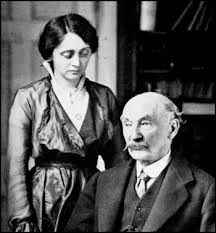“There was something terribly amiss with an institution that yoked two individuals for the rest of their lives. Monogamy was not a natural state for the human species, was his considered opinion. Love was a migratory phenomenon, not to be controlled by human laws, any more than a migratory bird might be controlled by borders and customs….”
 In this dramatic and illuminating fictionalized biography of author Thomas Hardy (1840 – 1928), Christopher Nicholson recreates a period in which Hardy experiences his highest personal excitements and his most bitter disappointments. At age eighty-four, Hardy is regarded as the wealthiest writer in England, but he is unable to focus on a new book and seems able to write only poems, most of which leave him dissatisfied. Living in Dorset in a house that he himself designed in England’s rural south, where he grew up, Hardy has remained in touch with the characters who people his novels, rural people living close to the land, far from hidebound London with its frustrating elitism. An iconoclast whose novels have often shocked his readers, Hardy has always depicted ideas and values that are in sharp contrast with those of the Victorian period – including issues of sex, marriage, and religious doubt, which, not surprisingly, reflect some of his own conflicts. Now in the winter of his life, Hardy wants to grasp a kind of happiness that has so far eluded him.
In this dramatic and illuminating fictionalized biography of author Thomas Hardy (1840 – 1928), Christopher Nicholson recreates a period in which Hardy experiences his highest personal excitements and his most bitter disappointments. At age eighty-four, Hardy is regarded as the wealthiest writer in England, but he is unable to focus on a new book and seems able to write only poems, most of which leave him dissatisfied. Living in Dorset in a house that he himself designed in England’s rural south, where he grew up, Hardy has remained in touch with the characters who people his novels, rural people living close to the land, far from hidebound London with its frustrating elitism. An iconoclast whose novels have often shocked his readers, Hardy has always depicted ideas and values that are in sharp contrast with those of the Victorian period – including issues of sex, marriage, and religious doubt, which, not surprisingly, reflect some of his own conflicts. Now in the winter of his life, Hardy wants to grasp a kind of happiness that has so far eluded him.
The author’s surprising decision to depict Hardy wrestling with some of these issues so late in his life – when it is almost certainly too late for Hardy make the kinds of changes necessary to achieve his goals – results in a picture of Hardy as a real person whose miserable marriages and disappointments in love have left him open to a surprising and unlikely attraction to an eighteen-year-old actress. Gertie Bugler, a local Dorset girl who is also a wife and mother, exudes the youth and demeanor which make her perfect for the part of Tess in the play Hardy has written based on Tess of the d’Urbervilles. As he dreams of providing Gertie with the chance to become the actress she has always hoped to become, he also dreams of what it would be like to elope with her into rare and profound happiness. For all his fantasizing, however, Hardy also realizes that “the world does not seem designed for the well-being of the human race… If there were a designer, he would appear to have been entirely indifferent to the happiness of humankind.”
Nicholson opens the novel with sublime passages about nature in the winter, very much in the tradition of Hardy’s own writing. At this stage of his life, Hardy has been married to his wife Florence for ten years. His first marriage (of thirty-eight years) to Emma Gifford, which started with promise, had quickly deteriorated, leaving Hardy married to a demanding woman who was estranged from him for most of their marriage. Only three or four days after Emma’s death, however, a new woman, Florence Dugdale, moved in to become Hardy’s secretary, and two years after that, they married despite their thirty-nine-year age difference. Now ten years have passed, and once again, Hardy’s marriage has deteriorated. Florence, now forty-five and childless, complains that Hardy’s house, Max Gate, is dark, depressing, and isolated, while Hardy himself, in the midst of a writer’s block, is unable to write novels and is dissatisfied with his poems. Eventually, Hardy cannot help but contrast his life with Florence with the one he imagines with young Gertie. In her, he expects there will be a “perfect reciprocity.”
Shifting points of view help keep the reader from “taking sides” in what becomes an intense marital drama. Florence, in her own voice, wonders if Hardy has ever been happy and sees her own life as filled with unanswered questions. She lets us know that he absolutely refuses to trim the trees which keep the house in near-darkness because he believes that they are “sentient” beings, while she believes that the spores from the trees, if inhaled, cause cancer, and she sees the house they share as a “shrine to Emma.” She resents the fact that he still holds a remembrance ceremony at Emma’s graveside each year, despite his years-long estrangement from her during her life. And when the play of Tess finally opens and Gertie gets rave reviews, Florence criticizes the “excessive praise” for Gertie’s beauty and resents Hardy’s new plan to sponsor Gertie for the Haymarket production in London. She believes she must take action.
Gertie’s point of view, presented in much shorter sections, fleshes out her role, and it is partly through her eyes that the reader learns about the atmosphere of Hardy’s home and his marriage to Florence, whose behavior toward Gertie soon becomes aggressive. Though Gertie remains a “thin” character here, her point of view expands in the conclusion of the novel, and it is in the final pages that we get a true feeling for Gertie and who she really is.
The author’s sensitively crafted dialogue shows the ill-fated attempts of Florence and Hardy to converse about long-standing issues, and it is impossible not to blame both Hardy and Florence for their difficulties. As each looks toward the future and sees how bleak it is, the reader, too, fears for the future for all three of the principals, especially Gertie, the most innocent.
Remaining true to the unlikely love story of an eighty-four-year-old man and an eighteen-year-old woman would have been a challenge for an author on any account, but Nicholson, through his varied points of view – Hardy’s in a respectful third person, and Florence’s and Gertie’s in first person – keeps the present and past, and the interior and exterior action moving swiftly and effectively. At one point, however, “Hardy” remembers a sexual interlude with first wife Emma which is presented in more graphic terms than any other episode in the novel, a scene which felt inconsistent, even intrusive, to me, perhaps included for its dramatic effect rather than as part of Hardy’s own point of view. The final conversations between Florence and Hardy, in which Hardy discusses his last wishes (several years before his actual death) sum up their relationship and their attitudes toward his death, with nature symbolism reflecting Florence’s attitudes: “A series of sharp noises, the urgent shrieks of a vixen calling for a mate, tore through the stillness of the night. She called repeatedly for several minutes before falling silent.” Ultimately, it is Gertie who has the last word, and her insights and ultimate behavior prove her to be the strong, honorable heroine one expects of Hardy’s rural women.
Photos, in order: The author’s photo appears on http://www.dailymail.co.uk/
Author Thomas Hardy and his wife Florence in the mid-1920s, about the time of this novel, are seen on http://spartacus-educational.com/
Max Gate, Hardy’s home in Dorset, newly restored and open to the public, is featured in this article: http://www.dailymail.co.uk/
Gertrude Bugler, as Tess, is found here: Photograph: National Trust / Simon Harris/Harris, Simon. http://www.theguardian.com
Gertie was anxious to play the part of Tess at the Haymarket in London in the mid-1920s, about when this photograph was taken: https://en.wikipedia.org/
ARC: Europa Editions





